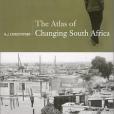《The Atlas of Changing South Africa》是一本圖書,作者是Christopher, A.J.
基本介紹
- 外文名:The Atlas of Changing South Africa
- 作者:Christopher, A.J.
- 出版時間:2000年10月
- 頁數:272 頁
- ISBN:9780415211789
- 定價:76.78 美元
內容簡介
SInce the first edition was published in 1994 as The Atlas of Apartheid , there has been enormous change in South Africa. Gradually apartheid is being dismantled but in many sectors the effects have not yet been reversed. In this new edition, A.J.Christopher examines the spatial impact of apartheid during the period of National Government from 1948 to 1994, and the legacy it h...(展開全部) SInce the first edition was published in 1994 as The Atlas of Apartheid , there has been enormous change in South Africa. Gradually apartheid is being dismantled but in many sectors the effects have not yet been reversed. In this new edition, A.J.Christopher examines the spatial impact of apartheid during the period of National Government from 1948 to 1994, and the legacy it has left for South Africa at the beginning of the twenty-first century. Apartheid was about the control of space and specific places. Intent upon maintaining white minority rule, despite local and international resistance, the government thought in terms of drawing lines on maps and on the ground to separate the South African peoples into discrete, legally defined groups in a classic example of divide-and-rule. Segregation operated at many levels and on many scales, from 'petty apartheid' exemplified by separate entrances to buildings and residential areas to 'grand apartheid' involving separate nation-states. It is remarkable that those structures associated with petty and grand apartheid have been dismantled very rapidly, but those associated with the ownership and occupation of land have been extremely persistent. In providing a comprehensive introduction to and detailed analysis of the policy of apartheid and its aftermath through more than 170 maps, The Atlas of Changing South Africa makes a unique contribution. By presenting it in visual, spatial forms most relevant to its conception, it illustrates the various levels of operation of the policy and its wider implications globally as well as nationally. edition illustrates with a wealth of maps, the spatial impact of apartheid in the period 1948-1994 and emphasises the changes and the continuing legacy, this presents to South Africans at the start of the 21st century. Those responsible for the imposition of the policy, thought in terms of drawing lines upon maps and on the ground, to separate people of different, legally defined groups. Apartheid was about the control of space and specific places. Therefore, the use of maps to communicate the old policies of Apartheid and to illustrate the recent changes, is highly appropriate. Intent upon maintaining white minority rule, despite local and international resistance, the Government of South Africa divided the peoples into discrete groups in a classic example of 'divide-and-rule'. Segregation operated at many levels and scales, from 'petty apartheid' exemplified by separate entrances to buildings and residential areas and finally to 'grand apartheid' involving separate nation states. It is remarkable that those structures associated with petty and grand apartheid have been dismantled very rapidly, but those associated with the ownership and occupation of land have been extremely persistent. Promises to reverse the effects of Apartheid have not been fulfilled in many sectors, as the Government seeks to undo nearly fifty years of legalised discrimination. The Atlas presents a comprehensive introduction and detailed analysis of segregation in South Africa as enforced by the National Party Government of 1948S1994 and the transitions which have occurred since then. The Atlas makes the unique contribution of presenting the policy and its impact in visual, spatial forms, most relevant to its conception, by including over 170 maps. These show the various levels of operation within the policy and the wider implications for it, globally as well as nationally.

